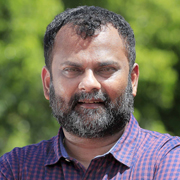Lucknow: The Defence Research and Development Organisation (DRDO) has been under increased spotlight and scrutiny in the last few years, with the current government demanding an increased pace of self reliance. DRDO Chairman Dr Gundra Satheesh Reddy, who took charge of DRDO in August 2018, reveals DRDO's new line of thought and focus areas. Excerpts from an exclusive interview with Onmanorama on the sidelines of Defence Expo.
DefExpo 2020
We had around 40 labs displaying more than 500 systems at DefExpo2020 making it the largest ever participation by a single organisation in any expo held in India. Our focus was to showcase our capabilities and matured systems along with the industries. We are committed to the vision of the government which has given defence export mandate of $5 billion in the next five years. We have taken several steps to reduce the import content in defence manufacturing by looking at various means to boost the indigenous contribution.
At DefExpo, we have handed over 15 transfer of technology (ToT) licenses to 17 industries in the areas of electronics, laser technology, sensors, combat vehicles, armaments, life sciences, aeronautics, materials science and naval systems. We are focused on enhancing self-reliance and operational capabilities of our Services. As a result, there will be new collaborations in R&D for futuristic systems so that India becomes a net exporter in the next five to 10 years.
AI, Space, Cyber
DRDO has taken great strides in the areas of space, cyber, artificial intelligence (AI) and related technologies. With space and cyber being the fourth and fifth dimensions of warfare, DRDO has taken big steps in these directions. Work on AI has been taken up specifically by two labs.
In the coming years, I believe every weapon and equipment will be driven by AI. We need to put lot of young talent to meet the challenges. A road map on AI will be in place.
There is a dearth of young talent in DRDO. It is one thing we need to work on. We are seriously looking at a mechanism how young talent can be taken in large numbers. I feel youngsters can contribute a lot on cyber technology. We have already started work on this area.
On the space front, we have already demonstrated ASAT capabilities. We are not going to weaponise space, but we also want to ensure that our space is secure.
Road Ahead
Our road map for next five years is very clear. We are working on LCA MK-2, AMCA and Naval LCA. We are strong in the areas of missiles, radars, torpedoes, electronic warfare systems and sonars. In these areas we want to have complete self-reliance.
Meanwhile, we are looking at the areas of concern and are taking the help of academic institutions. We want to bring industries to the level of build-to-specification, so that we can offload production to them and concentrate on design and development of large systems. The synergy between DRDO, academia and industry is the key.
Young Scientists
We have recently created five DRDO Young Scientist Laboratories (DYSLs) in Bengaluru, Mumbai, Chennai, Kolkata and Hyderabad. These labs are working on advanced technology areas such as AI, quantum technologies, cognitive technologies, asymmetric technologies and smart materials.
All scientists working here are below 35 years including the Director, who has the same powers as any other DRDO lab director. We are keen to have a vibrant environment in these labs.
In the next one year, they will be able to come up with substantial state-of-the-art technologies of value to defence applications.
Missile Matters
In the last one year we saw multiple success on the missile front. Various trials of Astra, quick reaction surface to air missile (QRSAM ), Nag and Pinaka were successfully completed.
This year the user trials of HELINA missile and man portable anti tank guided missile (MPATGM) will be completed. Development trials of new generation anti radiation missile (NGARM ) will be taken up this year. We are also working on Astra Mk-2 long range air-to-air missile. There are several other missiles that are in the pipeline.
On the weapons front, we have developed the Advanced Towed Artillery Gun System (ATAGS) in collaboration with Tatas and Bharat Forge. This year the system will undergo user trials. We are also developing the Joint Venture Protective Carbine (JVPC) and smart anti-airfield weapon (SAAW) bomb.
I am confident that SAAW will complete its trials this year and enter into production. There are many other weapons also being developed simultaneously.
Delays & Deadlocks
We are addressing this issue where ever we are encountering delays. We are getting into the depth of the matter to trace the cause of delays.
But, I must tell you that multiple changes are happening in DRDO and speed is the new mantra. We have become very aggressive with our time frames. Development trials of QRSAM, guided Pinaka missile and SAAW also have been completed. These are all completed as per exacting global standards and tight schedules.
We have laid down an aggressive schedule for LCA Mk-II (MWF: Medium Weight Fighter) and Advanced Medium Combat Aircraft (AMCA). I am sure of developing these systems in a record time.
Everyone is motivated in DRDO today, especially the youngsters. Youngsters are coming with many new ideas in the area of defence technologies. Many youngsters are doing wonders in these areas, even outside DRDO. My advice to youngsters is that whether you work with DRDO or any private industry in India, work to develop globally best in class systems. Let’s prove that India is not only good at Internet and communications technology (ICT) areas alone, but in the field of defence technology as well.
(The writer is an independent aerospace and defence journalist, who blogs at Tarmak007 and tweets @writetake.)


















